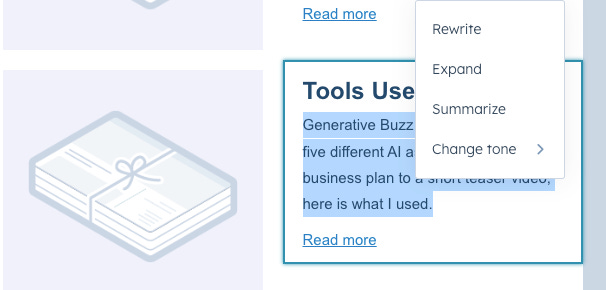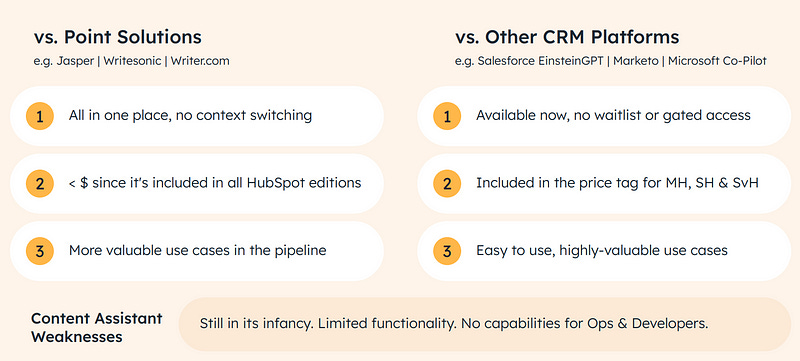Initial Thoughts on GPT Integration in Hubspot
Hubspot has moved its GPT-based Content Assistant to a public beta for all subscribers to its platform. Unlike Salesforce Einstein, Hubspot’s GPT implementation is free to all subscription levels. That being said, the GPT implementation is fairly limited to only blog and email writing.
As a Hubspot partner, I took the sales training for Content Assistant, then took the tool for a test drive. While limited in capability, I was impressed with the modest implementation. Here are my initial insights on Content Assistant, both positive and negative.
1) Basic Tactical Use Cases Only
In its current incarnation, Content Assistant is strictly tactical, with limited use cases focused on blog writing, sales email content creation, and marketing email editing. While content creation is one of the three primary marketing use case types I have identified (more on that in the forthcoming blog), it may be the least useful from a strategic perspective.
This is fairly common for AI launches today. Companies add GPT or a competing LLM to their software and call it a generative AI product.
I subscribe to the increasing market position that LLMs become extraordinarily powerful for an enterprise when they are trained on that brand’s content and data in a private implementation. The original content informs all executions of GPT, including summarization, and extending messaging to diverse media and content forms.
While Hubspot Content Assistant is free, Salesforce Einstein GPT may have a leg-up. Salesforce promises customers the ability to train their GPT implementations with their own data.
However, that does not mean non-Salesforce enterprises are left without that option. In addition to creating their own implementation, several startups offer these types of private implementations and integrate directly into Hubspot.
2) Domain-Specific Implementation
It’s clear that Hubspot didn’t just slap GPT into its software and unleash it. Content Assistant offers specific prompting to achieve a marketing result, effectively creating a domain-specific implementation targeted towards sales and marketing staff.
Initial generated content requests are limited to sections (paragraphs and conclusions), content ideas, and outlines. Once you or the bot write the content, you can have GPT rephrase, expand that content, summarize it, or change the tone of the written content.
Content Assistant is tailored to creating meaningful sales and marketing materials. In fact, one can see that Content Assistant’s modest rollout is very intentional in its customization.
3) One-Stop Shop

These types of domain-specific prompts are not unique in the marketing world. Many of the competing AI bots have their own domain-specific implementations (here are five such competitors). Some, like Jasper and Copy.ai, are definitely tailored to the unique needs of copywriters.
However, the winning formula for Hubspot is the native interface. Instead of having to write the content in ChatGPT or another tool, copy and paste it into Hubspot. Coupled with the free cost, you have a winning formula.
It is probable that second-tier text assistants will lose some customers with native integrations on the uptick. Further, these AI writing startups will feel great pressure to integrate with CRMs in a pragmatic, useful manner. Their capabilities will need to provide a significant advantage over Content Assistant and other GPT implementations for them to survive.
I expect continued movement toward native generative AI by Hubspot, Salesforce, Adobe, and other leaders, which in turn will force market consolidation.
4) Hands Off Approach to Governance
Governance is the most overlooked component of marketing AI implementations. How an organization manages source information (data), prompting, and usage guidelines, and then verifies, edits, and proofs AI outputs is the difference between extending your team’s content creation capabilities and annoying prospects with AI-generated drivel.
Hubspot offers a loose advisory on needing to check your content, but if you turn on Content Assistant, your entire salesforce will have access to GPT creation capability for their sales emails. This is a huge risk.
Great salespeople will be fine, but the rest of the staff needs to be trained on how to use this, ESPECIALLY given that the implementation is not trained on your content and data but rather on the general Internet and, I assume, the information sourced by the general Hubspot pool of users. Further, there is the hallucination issue and the lack of sources.
It cannot be said enough. Train your staff and put in fact-checking mechanisms before unleashing AI-generated content.
5) More to Come
As you can see from the above partner education slide, this is just the beginning for Hubspot’s Content Assistant. They acknowledge the limited functionality and current lack of opportunities for the development community. Expect Content Assistant to become much more robust over the next few months and years.
While these slides tease more use cases and greater access to Hubspot AI capabilities, ChatSpot.ai is a better indication of potential capabilities. Hubspot’s alpha chatbot has a robust series of potential prompts for sales and marketing executives, each of them domain-specific.
Capabilities include, but are not limited to:
Discovery of potential opportunities and competitors
Content Editor
Image generator
Keyword research
Tagline generator
Domain information
Clearly, Hubspot sees great sales and marketing potential for generative AI. I look forward to seeing how their capabilities evolve to the benefit of the larger Hubspot community.
This story is published on Generative AI. Connect with us on LinkedIn to get the latest AI stories and insights right in your feed. Let’s shape the future of AI together!












